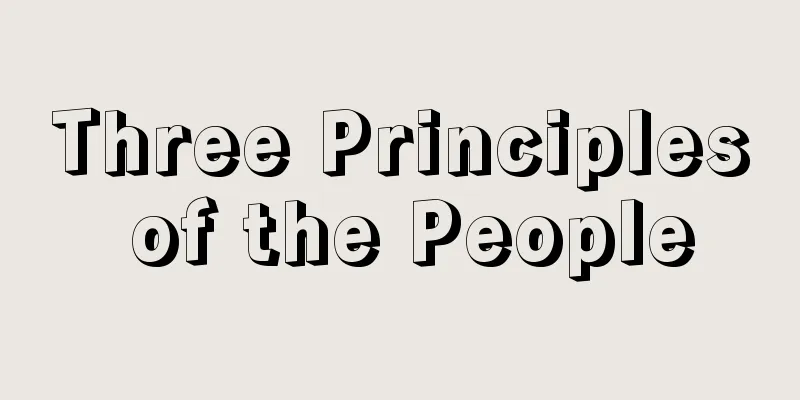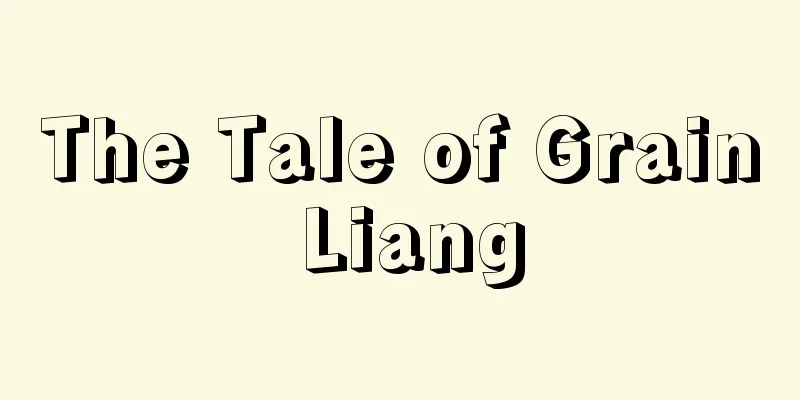Kojiki - Beggar

|
The oldest surviving historical book. It consists of a preface and three volumes: upper, middle, and lower. [Hiromichi Mayuzumi] Book titleIt was likely named "Kojiki" because it records ancient events from the Age of the Gods to the reign of Empress Suiko, but there is still no consensus as to whether it was read as "kojiki" (beggar) or "furukotobumi" (writing). [Hiromichi Mayuzumi] EstablishedThe process by which the Kojiki was created is explained in detail in its preface. Although there are theories that doubt the preface, I will introduce the process through the preface for now. Emperor Tenmu was dismayed by the fact that the Imperial Chronicles and the Old Testaments handed down to various families contained many falsehoods and deviated from the correct historical facts, and was worried that if this was not corrected now, the authentic traditions would soon be lost.He decided to personally examine the Imperial Chronicles and the Old Testaments, remove the falsehoods, establish the truth, and pass them down to future generations, and ordered Hieda no Are to recite and learn them.However, Emperor Tenmu soon passed away, and the reign of Emperor Jito and Emperor Mommu came, but during this time he was busy completing and enforcing the Ritsuryo system, and was unable to realize his original intention. Emperor Genmei, who succeeded Emperor Bunko, regretted this and on September 18, 711 (Wado 4), he ordered Oono Yasumaro (Yasumaro) to write down what Hieda no Arei had learned to recite and present it to him. Yasumaro then used various ingenious methods to write it down and compiled it into a three-volume book, which he presented to him on January 28 of the following year. In relation to this, there is a theory by Hirata Atsutane that the article in the "Nihon Shoki" for March 10th year of the Tenmu era (10th year of the Tenmu era) for the Heisei Era (3rd month of the Heisei Era), which reads, "The Emperor, in the presence of the Daigokuden, issued an order to Prince Kawashima, Prince Oshibane, King Hirose, King Takeda, King Kuwata, King Mino, 3,000 members of the Okinshiki lower Kamitsune no Kimi, the head of the Nakaimbe clan, the head of the Okinshiki lower Azumi clan, Inashiki, the head of the Naniwa clan, the head of the Oyamakami Nakatomi clan, Oshima, and the head of the Oyamashita Hiragi clan, to stipulate in the Imperial Chronicles and various matters of ancient times. Oshima and his head personally wrote and recorded them" is the very project to compile the "Kojiki," which is made up of the Imperial Chronicles and the Old Records. However, there is a huge difference in the number of people involved, and it is hard to imagine that they were the same project. Rather, this is likely to indicate the beginning of the project that led to the "Nihon Shoki." [Hiromichi Mayuzumi] ContentsThe first volume covers the Age of the Gods, the second volume covers the period from Emperor Jimmu to Emperor Ojin, and the third volume covers the period from Emperor Nintoku to Emperor Suiko. The first volume includes stories of the three gods of creation when the heavens and the earth first appeared, the seven generations of the Age of the Gods, Amaterasu Omikami, the transfer of the land of Izumo, the descent of the heavenly grandson, and the three generations of Hyuga, and explains the creation of the heavens and the earth and all things, the origin and legitimacy of the imperial rule, etc. The middle volume begins with Emperor Jimmu's Eastern Expedition, and through the Eight Missing Generations, it traces the expansion and strengthening of royal power and the development of the imperial lineage, focusing on the legends of heroic figures such as the Generals of the Four Provinces, Yamato Takeru no Mikoto, Empress Jingu, and Emperor Ojin. The second volume describes the internal conflicts that led to the end of the monarchy under the tyrant Buretsu, including the tragic story of Prince Karu and the wandering tales of the two princes (Kensou and Ninken), and ends with the addition of information from the appearance of Emperor Keitai to the reign of Empress Suiko. It is noteworthy that there are no elements of the Koji in the Eight Missing Generations in the middle volume and in the section after Ninken in the second volume, and only articles in the style of the Imperial Chronicles. Regarding the former, it is thought that there may have never been any koji to begin with, given the doubts about the existence of the eighth emperor, but regarding the latter, it is understood that the era of oral literature in which koji could be created has come to an end. Generally speaking, it can be said that the first volume deals purely with the age of the gods, the second volume with the era when gods and humans were undifferentiated, and the third volume with the era of humans purely. So why did he stop at Empress Suiko and not go on to Emperor Jomei and later? A major factor in this is thought to be that all the emperors after Jomei were descendants of Jomei and were from a different lineage than Empress Suiko, whose mother was a member of the Soga clan. For Emperor Tenmu, the accession to the throne of his father, Emperor Jomei, was the root of his own becoming emperor. Therefore, he probably felt that the circumstances surrounding Jomei's accession to the throne needed to be described in detail again, and so he decided to include the period up to Suiko in the Kojiki for the time being. For the emperors who were in the period when the Kojiki and Nihon Shoki were compiled, the period before Suiko was, so to speak, pre-modern, and the period after Jomei was modern and contemporary. This is also why the period after Jomei is included in the Nihon Shoki. [Hiromichi Mayuzumi] How to take notesSince the contents of this book are mainly ancient traditions, it required ingenuity to transcribe them without losing the original form of the handed down tradition. Using only Man'yōgana would have been too lengthy, and using classical Chinese would have been risky in losing the main meaning. So a compromise was made between the two, with annotations added where necessary, and special care was taken with the writing of honorifics and auxiliary verbs unique to Japanese. This is one of the differences with the "Nihon Shoki" which is written in classical Chinese. As such, it is not only a valuable document in the fields of Japanese literature and linguistics as the oldest classic of Japanese writing, but its contents also serve as research material in mythology, ethnology, and history. For this reason, not only are there many specialist researchers of the Kojiki, but there are also many other researchers who use it as material for their research. [Hiromichi Mayuzumi] Purpose of CreationThe purpose of compiling the Kojiki was to organize and unify the various imperial chronicles and ancient writings that had been passed down by various families under the authority of the Emperor, thereby further strengthening the authority of the Emperor and historically proving and rationalizing the legitimacy of imperial rule. For that reason, along with the "Nihon Shoki," it was revered as a sacred text and the fundamental scripture for the existence of the imperial system, and until the Middle Ages, it was primarily interpreted in mystical and Shintoistic ways. However, from the early modern period onwards, literary and Confucian research also emerged, and Motoori Norinaga in particular compiled literary and Shintoistic research into the "Kojiki-den," marking a new era in the history of research on the Kojiki, but he was still unable to break away from his mystical tendencies. In modern times, critical research by Tsuda Sokichi, Orikuchi Shinobu and others was published against the backdrop of the liberal climate of the Taisho period, but in the Showa period, such research was suppressed and nationalistic and godlike trends gained momentum. In 1945 (Showa 20), freedom of research was guaranteed following Japan's defeat in the Second World War, and all taboos on the study of ancient history were eliminated, leading to the resumption of research on the Kojiki from an objective and scientific standpoint, but in recent times, there has been a growing trend to reevaluate the achievements of the Taisho period and overcome them. [Hiromichi Mayuzumi] ForgeryThe theory that the Kojiki is a forgery, which has existed since the late Edo period as one of the results of critical research on the Kojiki, has received further support in modern times, but as of today nothing conclusive has been found, and the majority of academic circles have not yet accepted it. [Hiromichi Mayuzumi] "Complete Works of Motoori Norinaga, ed. Susumu Ohno, Volumes 9-12, Kojiki Biography (1989, Chikuma Shobo)" ▽ "Complete Works of Japanese Classical Literature, Kojiki and Norito, New Edition (1993, Iwanami Shoten)" ▽ "New Edition of Complete Works of Japanese Classical Literature, Volume 1, Kojiki" (1997, Shogakukan) [References] | | | | | | | | | | | | |Nihon Shoki| |Hieda no Are| | |A later publication. The opening part of the second volume, which describes the period from Emperor Nintoku (Ootori no Mikoto) to Empress Suiko (Toyomikazeki-takiyahime). Edited by Taianmaro. Owned by the National Diet Library . "Kojiki" Source: Shogakukan Encyclopedia Nipponica About Encyclopedia Nipponica Information | Legend |
|
現存最古の歴史書。序文および上・中・下の3巻よりなる。 [黛 弘道] 書名神代から推古(すいこ)天皇に至るまでの古事を記録したところから『古事記』と命名されたのであろうが、これを「こじき」と読んだか、「ふることぶみ」と訓(よ)んだかについてはいまだ定説はない。 [黛 弘道] 成立『古事記』の成立過程はその序文に詳しい。序文を疑う説もあるが、とりあえず序文によってその経緯を紹介しよう。 天武(てんむ)天皇は、諸家に伝える帝紀(ていき)および旧辞(きゅうじ)が正しい史実に違い虚偽を加えるところが多いのを慨(なげ)き、いまにしてこれを正さなければ真正の所伝は幾(いくばく)もなくして滅びてしまうであろうと憂え、ここに自ら帝紀・旧辞を検討し、虚偽を削り真実を定めて後世に流伝させようと決心し、稗田阿礼(ひえだのあれ)に命じてこれを誦(よ)み習わせたのであった。しかるに、やがて天武天皇は世を去り、持統(じとう)・文武(もんむ)朝となったが、この時期は律令(りつりょう)制の完成・施行に忙しく、その初志を実現することができなかった。文武の後を受けて即位した元明(げんめい)天皇はこれを遺憾とし、711年(和銅4)9月18日、太安万侶(おおのやすまろ)(安麻呂)に詔して、稗田阿礼の誦み習うところを筆録し献上せよと命じた。そこで安万侶は種々くふうを凝らしてこれを筆録し3巻の書物とし、翌年正月28日に奏上した、という。 なお、このことに関連して『日本書紀』天武10年3月丙戌(ひのえいぬのひ)条の「天皇御于大極殿、以詔川島皇子・忍壁皇子・広瀬王・竹田王・桑田王・三野王・大錦下上毛野君三千・小錦中忌部連首・小錦下阿曇連稲敷・難波連大形・大山上中臣(なかとみ)連大島・大山下平群臣子首、令記‐定帝紀及上古諸事。大島・子首親執筆以録焉」という記事を、帝紀と旧辞とよりなる『古事記』編纂(へんさん)事業そのものであるとする平田篤胤(あつたね)の説があるが、陣容に差がありすぎ、同事とはとうてい考えられない。これはむしろ『日本書紀』につながる事業の発端を示すものであろう。 [黛 弘道] 内容上巻は神代、中巻は神武(じんむ)から応神(おうじん)まで、下巻は仁徳(にんとく)から推古までの記事を収める。上巻は天地初発(あめつちはじめてひらくる)ときの造化三神、神世七代(かみのよななつぎ)、天照大神(あまてらすおおみかみ)、出雲(いずも)の国譲(くにゆず)り、天孫降臨(てんそんこうりん)、日向(ひゅうが)三代などの物語を載せ、天地・万物の生成、天皇支配の起源と正当性などを説明する。中巻は神武東征(とうせい)に始まり、欠史(けっし)八代を経て、四道将軍(しどうしょうぐん)、倭健命(やまとたけるのみこと)、神功(じんぐう)皇后、応神天皇ら英雄的な人物の伝説を中心に王権の拡大強化と皇統譜の展開を跡づけている。下巻では聖帝仁徳の王統が暴君武烈(ぶれつ)に至って絶えるまでの内紛を軽太子(かるのたいし)の悲話、二王子(顕宗(けんそう)・仁賢(にんけん))の流離譚(りゅうりたん)などを絡めて叙述し、継体(けいたい)の登場から推古の治世までを付加して終わる。中巻の欠史八代と下巻の仁賢以後の部分には旧辞の要素はまったくみえず、帝紀的な記事のみであることが注目される。前者については、八代天皇の実在性に疑いがもたれていることと関連して、もとより旧辞などなかったとも考えられるが、後者については、もはや旧辞がつくられるような口承(こうしょう)文学の時代は終わったのだと理解されている。 総じていえば、上巻は純粋な意味で神々の時代を扱い、中巻は神と人間の未分化の時代を、下巻は純粋に人間の時代を扱ったものといえるであろう。 では、なぜ推古天皇までで筆を止め、舒明(じょめい)天皇以降に及ばなかったのであろうか。それには、舒明以後の天皇がすべて舒明の後裔(こうえい)で、蘇我(そが)氏を母にもつ推古天皇とは別系であることが大きな要因となったと思われる。天武天皇にとって父舒明天皇の即位は自らが天皇となりえた根源である。それゆえ、舒明即位の経緯は改めて詳細に記述する必要があるとし、さしあたり『古事記』には推古までを収録することとしたのであろう。記紀成立期の天皇にとって推古以前はいわば前近代、舒明以後こそ近・現代であった。『日本書紀』に舒明以後を収める理由もここにある。 [黛 弘道] 筆録の方法本書の内容が古伝承を主とするだけに、所伝の本姿を失うことなく筆録するにはくふうを要した。万葉仮名だけでは冗長にすぎるし、漢文では本旨を損なうおそれがある。そこで両者を折衷し、必要に応じて注を施し、日本語特有の敬語や助動詞の表記には格別の注意を払った。漢文体の『日本書紀』との相違の一つはここにある。 したがって、国文体の最古の古典として国文学・国語学上の貴重な文献であるのはもちろん、その内容は神話学・民族学・歴史学の研究資料ともなる。そのため『古事記』の専門研究者も多いが、これを研究の一素材とする各種の研究者もまた多く存在する。 [黛 弘道] 作成の目的『古事記』作成の目的は、諸家に伝える各種の帝紀・旧辞を天皇の権威によって整理統一し、それによって天皇の権威をいっそう強め、天皇支配の正当性を歴史的に証明し合理化しようとするところにあった。 そのため、『日本書紀』とともに天皇制存立の根本聖典として神典と崇(あが)められ、中世までは神秘的・神道的な解釈がもっぱら行われたが、近世以降、文学的・儒学的な研究も現れ、ことに本居宣長(もとおりのりなが)は文学的・神道的研究を『古事記伝』において集大成し、研究史に一期を画したが、なお神秘主義的傾向から脱却できなかった。 近代になると、大正期の自由主義の風潮を背景に津田左右吉(つだそうきち)、折口信夫(おりくちしのぶ)らの批判的研究が公表されたが、昭和に入るとそのような研究は圧迫され、国家主義的・神がかり的な風潮が高まった。1945年(昭和20)第二次世界大戦の敗戦により研究の自由が保障されると、古代史研究のタブーはいっさい排除され、それに伴って『古事記』の研究も客観的・科学的な立場から再開されたが、近時は、それに加えて、大正期の業績の再評価とその克服を志向する空気が強まりつつある。 [黛 弘道] 偽書説『古事記』の批判的研究の一つの成果として江戸後期からある偽書説は、近代に入ってその論拠をさらに加えたが、今日までのところでは、いまだ決定的なものはなく、学界の大勢はこれを認めるに至らない。 [黛 弘道] 『大野晋編『本居宣長全集9~12 古事記伝』(1989・筑摩書房)』▽『『日本古典文学大系 古事記・祝詞』新装版(1993・岩波書店)』▽『『新編日本古典文学全集1 古事記』(1997・小学館)』 [参照項目] | | | | | | | | | | | | | | | | | | | |後世の刊本。仁徳天皇(大鷦鷯尊)から推古天皇(豊御食炊屋姫)までを記した下巻の冒頭部分。太安麻呂編国立国会図書館所蔵"> 『古事記』 出典 小学館 日本大百科全書(ニッポニカ)日本大百科全書(ニッポニカ)について 情報 | 凡例 |
Recommend
Sacrifice Festival - Kugisetsu
It is celebrated on the morning of the end of Ram...
Variant angina
...In 1768, William Heberden (1710-1801) of Engla...
Okra - okra (English spelling)
A perennial plant of the Malvaceae family (APG cl...
Orchestral music
(1) The name of a style of gagaku music. Formerly ...
Spiny dogfish - North Pacific spiny dogfish
The name of a species of the Squalus genus in the...
Stock price manipulation - Kabukasousa
...Artificial manipulation of securities prices. ...
Guanabara [State] - Guanabara
...Average humidity is 77%. In contrast to the ro...
Silk weaving - Kinui-doori
…A type of silk fabric, an abbreviation of 's...
Koya version - Koyaban
These are Buddhist scriptures published at Mount ...
Villon, Jacques
Born July 31, 1875 in Danville [Died] c.1963. Fren...
Liang Shiyin (English spelling)
1869‐1933 A Chinese politician during the Republic...
How is a scientific theory born?
…To “discover” something (whether a fact or a the...
Sutra holder - Jikyouja
〘Noun〙 (also "jikyousha") A Buddhist ter...
Abd al-Wahhab, M.
... Egyptian popular music developed in its own w...
Adsorption - Adsorption
When two phases are in equilibrium, the concentra...









